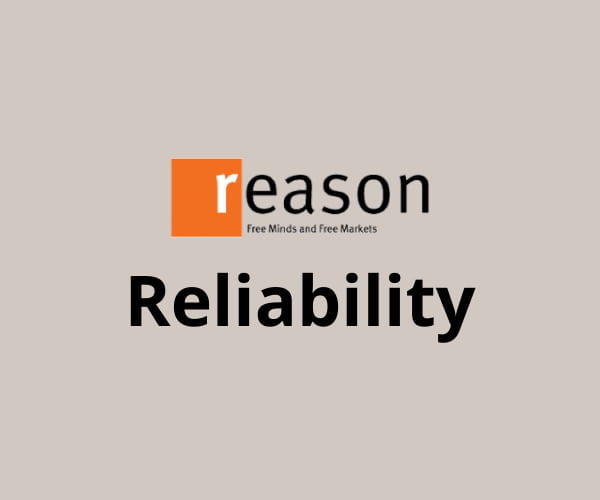
The “nation’s leading libertarian magazine” produces a monthly print and digital circulation of over 50,000 as well as 4 million website visits a month. As such, Reason has a substantial audience that touches on topics varying from civil liberties, politics, policy, technology, and more.
With that being said, the publication at Reason cannot always be accurate. Is this independent libertarian source as accurate as it claims to be? At Biasly, we look to evaluate the accuracy and dependability of all media outlets. This article will investigate the reliability and accuracy of Reason.
Does Reliability Matter?
Reliability, in general, refers to how trustworthy or accurate information, or in this case, a news source is. If we consider this definition, it quickly becomes clear why reliability is important in media sources. If we can’t trust the things we read then there isn’t much of a point in continuing to consume content from that source, after all. So how exactly can we gauge the reliability of a news source anyways?
There are several potential measures of reliability to look out for when trying to determine whether a media source is reliable or not. Red flags for an unreliable article can include the presence of wild unsubstantiated claims, facts dependent on other unreliable sources, heavy use of opinionated language, and more. Some indicators of a reliable news source, on the other hand, include things like:
- Absence of subjective/opinionated language in articles
- Credible sources cited (e.g., neutral sources, .gov, .edu websites)
- Facts and statistics backed by multiple relevant outside sources
- Use of primary sources when possible (e.g., interviews, quotes)
- Information that remains consistent across news sources
So How Does Reason Fare in its Reliability?
The political reliability index developed by Biasly objectively assesses news organizations’ accuracy and trustworthiness. Reason’s overall Reliability Score has been rated as ‘Good’ by Biasly. This rating is a weighted average of two distinct scores: the Fact Analysis Score and the Source Analysis Score, each evaluating separate components of Reason’s Reliability. When computing the Average Reliability of the article the Fact Analysis score is more heavily weighted. These ratings are as follows in the next two paragraphs:
Reason’s Fact Analysis Score is ‘Good,’ which suggests readers can trust most of Reason’s content online. The Fact Analysis score focuses more on the accuracy of claims, facts, and sources presented in the article and any hints of selection and omission bias, which we will discuss further in the article.
Reason’s Source Analysis Score is ‘Good,’ which suggests readers can trust most of the sources, links, and quotes provided by the news source. This score, which is based on A.I., focuses on assessing the quality of sources and quotes used including their number, lengths, uniqueness, and diversity.
However, since these scores are based on percentages and averages, individual articles could be more or less trustworthy depending on the context, author, and other factors. Our findings show that Reason’s reliability is mostly but not all factual because they have retracted several stories in the past or had pieces that were not factual.
Let us analyze the supporting data for Reason’s rankings and discuss what to watch out for while searching for trustworthy news sources.
Reason Accuracy and Reliability
Reliability of news sources is significantly impacted by an organization’s bias and political orientation. By evaluating Reason’s integrity in their news sources, we will deduce how well they support claims with ample evidence, check for selection and omission bias, and ultimately assess the correctness and factuality.
Selection bias is when stories and facts are selected or deselected, often on ideological grounds, to create a narrative in support of the new sources’ ideology. Omission bias, on the other hand, is when different opinions and political views regarding a situation are left out so that the reader is only exposed to the ideological perspective supported by the author. It’s important to keep in mind these two types of biases when trying to assess an article’s level of accuracy.
Biasly aligns a percentage score for accuracy, ranging from least accurate (one) to most accurate (one-hundred). These ratings are calculated by weighing assertions with supporting evidence, number of reliable internal sources used and number of external sources used. A full page on Biasly’s website includes these reliability ratings for newly released Reason articles– click here to check it out. Nevertheless, recall that Reason has been deemed to have “Good” reliability, although this score will vary between articles and their topics. The most extreme discrepancies in dependability are caused by bias, specifically selection and omission bias.
Consider also, the Washington Post, who has a Somewhat Liberal bias and has “Good” reliability according to Biasly. For example, they had one article rated “Excellent” reliability titled “The claim that crime falls when states relax gun-control laws” while an article rated “Good” reliable, titled “Rep. Louie Gohmert has set the new (low) bar for downplaying the Jan 6. riot.” As a result, stories displaying a stronger political leaning (especially in their title) are often less reliable than neutral ones.
For example, this Reason article titled “Politics Is Seeping Into Our Daily Life and Ruining Everything” is rated at Center. Concerning its selection and omission bias, author J.D. Tucille selects facts that underscore the drastic left-right divide:
“The researchers find that people’s chosen political identities become self-reinforcing through associations with groups with shared beliefs. Our associations can even create a ‘group-specific shared reality’ that makes it harder to relate to those with opposing views.”
“Even before political tensions hit their current fever pitch, a 2018 survey found that ‘Nearly two-thirds (64 percent) of consumers around the world will buy or boycott a brand solely because of its position on a social or political issue.’”
Given that this article was rated at the Center, this indicates that the author does not explicitly support one side of the political spectrum more than the other. Similarly, the author omits any sort of emotionally loaded examples of political disagreements and rather looks to highlight that the removal of politics in our day to day life is healthier:
“Making politics less important through reducing the ability of government to affect our lives has the potential to make us all healthier and happier.”
As such, this central article describes politics and government’s negative effects on our life. With this being said, the article supports an ideological perspective that does not prefer one political party or the other– something that all news sources should strive to achieve.
We will take a closer look at more examples like this below, looking further into Reason’s reliability. The following section includes a deeper dive into selection bias, omission bias and the quality of sources and facts used.
Analysis of Reliability in Reason Pieces
Opinion-style journalism, or independent journalism in Reason’s case, is a suitable outlet for writers to express their opinions and beliefs, although excessive opinion is something that we want to avoid in a general news article. Although opinion-pieces are less accurate because they are subjective, they are still worthwhile to read to broaden our political understanding and viewpoints.
With zero failed-fact checks in the past five years, this indicates more accurate reporting from Reason. Their commitment to independent journalism and their goal to “deliver fresh, unbiased information” will be put to question below.
Quality of Sources and Facts Used
Reason can be good at using reliable sources and including both sides of the political ideological divide. For example, continuing to look at the article from earlier, “Politics Is Seeping Into Our Daily Life and Ruining Everything.” This article from J.D. Tucille features a total of fifteen quotes, twelve being medium-long length and three being short quotes. Additionally, the author cites five sources throughout the article:
- Journal of Public Policy & Marketing– researches from Arizona State University, University of Wyoming and four other universities
- Edelman
- Christine Moorman from Forbes
- Wall Street Journal
- American Social Review– Daniel DellaPosta from Penn State University
Overall, the article features an excellent quality of sources, including multiple, unique sources while providing opposite sources as well. For example, Forbes, who has a “Center” media bias rating is quoted alongside Wall Street Journal, who’s rating is “Somewhat Conservative.”
The article also pulls from Edelman, a leading global communications marketing firm that partner’s with some of the world’s largest businesses and organizations. With several awards such as the Cannes Lions Grand Prix for PR and one of 2018’s “Agencies to Watch” by Advertising Age, it is clear that this is a reliable source, where the article pulls this meaningful and informative data point: “Two-thirds of consumers worldwide now buy on beliefs.”
So, between the quality of sources and facts used, it is safe to say that this article has a range of sources which all holistically cover the issue of political science and government in our everyday lives.
Selection and Omission Bias
There are instances, however, where Reason does have emotionally loaded language in their article titles, such as “The Winningest Loser’s in Trump’s Trade War.” While author Veronique attempts to address both good and bad points of the former President, her subtitle stating “The president’s agenda hurts American consumers and businesses” clearly presents her political stance and essentially notifies readers that the article will have an opinion-induced bias as well. Further, she goes on to acknowledge some good developments, such as:
“A fast-growing economy, a palpable business optimism, a much-needed lower corporate tax rate, and fewer regulations come to mind.”
The remainder of the article explains the many losses that Americans are experiencing from the presidency and the impacts of tariffs– as such, the author selects these stories and facts on ideological grounds to support the author’s ideology. For example,
“In theory, the goal for all of this trade disruption was to negotiate lower tariffs. In reality, it hasn’t worked. Global tariffs have gone up.”
“Making matters worse, these companies now have to compete with foreign imports of final goods whose costs haven’t been raised by tariffs and hence are cheaper but of equal quality.”
“The bottom line is that when it comes to trade, this type of winning sure looks like a lot of losing.”
Similarly, while I would say and do acknowledge an attempt to prevent omission bias is present in the introduction of the article, the overall tone of the piece exposes the reader to the ideology supported by the author. So, on the one hand, you could argue that there is no omission bias, because an opposite political view of the situation is included:
“We were told that if Donald Trump were to get elected, we’d be winning so much that we would become bored with winning. To be fair, some good developments have taken place under this president.”
So, in opinion pieces, it is possible that issues with factuality, sources, selection and omission are often present. The articles covered so far do include bias and can exclude information that would perhaps contradict the author’s stance. As a news organization with a slight-right leaning stance, Reason does have an incentive to continue to appeal to its libertarian audience to maintain their interests. Now that we’ve discussed factors that influence reliability and credibility in media articles, you can stay informed on the most accurate news.
So is Reason Reliable?
In conclusion, it can be argued through our analysis that Reason is typically a highly reliable news source with a strong reputation for libertarian and independent journalism. However, the more you research reliability and accuracy, the easier it will be to spot issues with sources, selection and omission bias and factuality. Biasly’s News Bias Checker is a critical resource to uncovering these reliability issues and guaranteeing you to find the most accurate news.






















